 Part Two: Basic Education
Part Two: Basic Education
Horses don’t come with a manual. The rider needs to know the aims of training.
Many trainers don’t know enough about basic education for young horses, says Susanne Miesner, Master of Horse Management in Germany and author of specialized books. Very often riders and breeders try to teach their youngsters on their own, without the help and guidance of an expert. In the first of our series Susanne gave us guidelines to assess if we are ready to train a young horse, next she tells us more about basic education. Susanne, like many other top riders and trainers, is especially grateful to the late Paul Stecken, the former director of the Westphalian Riding and Driving School in Münster who provided her with many invaluable hints from his vast knowledge of the training of remounts at cavalry schools.
Once we had a term for young horses: remount. Unfortunately this word has been forgotten and now the expression is rarely used. Today we talk of young horses, but this not very precise. A young horse can be anything from a foal, to a six-year-old show horse. The term remount is more specific: we talk about a four-legged student in basic training for the first two years of being a riding horse.
To have clear objectives helps us to reach them, “Only those who have objectives will find ways to reach them.”
This quote not only applies to visions of life in general, but also to the basic training of a young horse. Simple, you may say. But on looking more closely we may find that many riders can’t even identify their goals. Their expectations are too high and they ask too much of their young horse too quickly. The remount in the cavalry had two years of primary school to become a riding horse. For today’s young horses this has become a luxury rarely enjoyed. The drive for success and money is not only restricted to our sport, but excessive ambitions can do lasting damage to young horses.
The young horse in natural balance and in swinging motion, just as it should be going with the rider at a later stage
Riding on one’s own has become usual these days in Germany. This means no everyday instructor, as is usual in most other parts of the world, but also the absence of other horses that could give a feeling of security to the young horse. To follow a leading horse has gone out of fashion – but the horse still remains a herd animal.
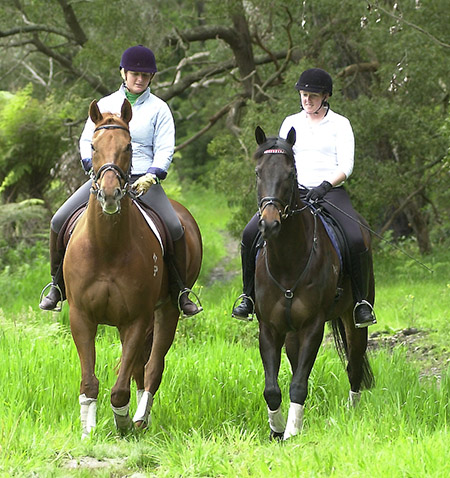
A young warmblood and his older Thoroughbred companion…
To reach a major aim the rider needs many small aims. Following them, they can check whether they are on the right track. Every stepping stone builds on the previous one. If one is missing and the rider continues regardless they will take the problem with them until one day the whole thing falls apart. As in the primary school, if the student doesn’t pass his first exam or is not considered mature enough, he will not be promoted to second class hoping he can make it there. It is the simple but basic things that need the most work.
Where to start?
Training starts with familiarization
We must always remember that the horse, by its anatomy, is not meant to carry weight. Therefore the most important task after getting him used to the saddle is getting him used to the weight of the rider. The horse needs enough time for that. It is better to train five times a week for ten to twenty minutes than three times a week for half an hour. The horse may develop muscle soreness which can take a long time to disappear. It is especially important during this period of his training that the horse has the opportunity to enjoy some free movement out in the paddock.
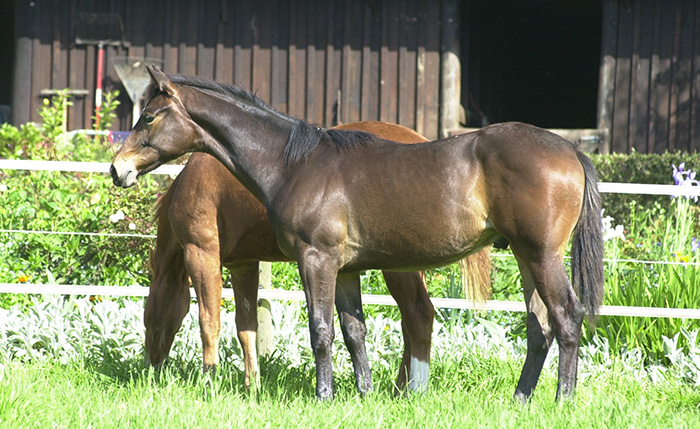
In Germany, after the first backing a remount is usually ridden two to three times on the lunge line until he has established some trust. Afterwards the free riding begins. With nervous and restless horses, but also with those that don’t want to move forward, the use of a lead horse is recommended. It makes understanding and moving so much easier for the youngster. The aim is to have the remount walking and trotting – and for very short periods, cantering – straight and forward along the outside of the working area. We want him to gradually respond to the leg and want to bring him back by voice and very soft aids on the bit. The rider should not use spurs but may carry a short whip to reinforce the forward aids. If the whip is used it should be done by touching the shoulder. Slowly the horse learns to follow the orders of the rider and his aids. Praising often is important to build trust, but persistence is necessary also, especially as far as respect for the driving aids are concerned.
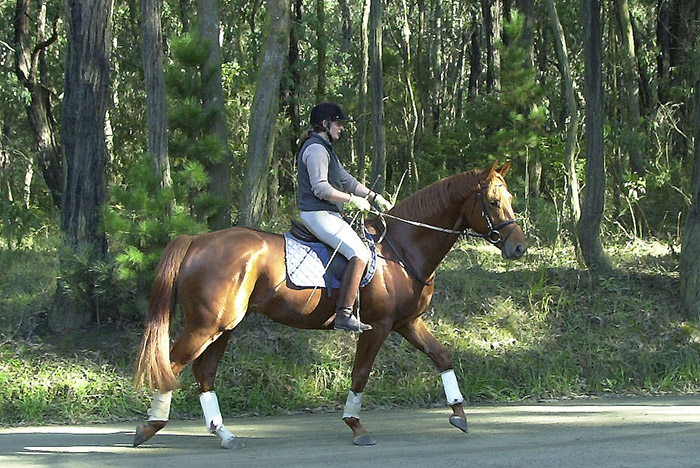
Another lesson for the remount to learn during the first months is to walk on a long or even loose rein after the rider has mounted. A quiet walk for about ten minutes improves the outer and even more importantly, the inner relaxation of the horse. Provided there is enough opportunity for free movement at other times, a free walk should be achievable with every horse. If you can’t put the horse out in a yard or paddock for some time each day, preparation on the lunge line might be a help.
The basics:
Rhythm, looseness and contact
Most important during the first months of training are rhythm, looseness and the right amount of contact according to the horse’s age. This is not to be confused with being on the bit. If the horse becomes too short or resistant through the neck it breaks at the third vertebra, stiffens the back and can no longer step forward from behind towards the bit. This results in jerky movements, problems with rhythm, being behind or above the bit, general dissatisfaction or resistance. A horse just started should be ridden with light contact but no control over the neck. The horse needs the neck for balance.
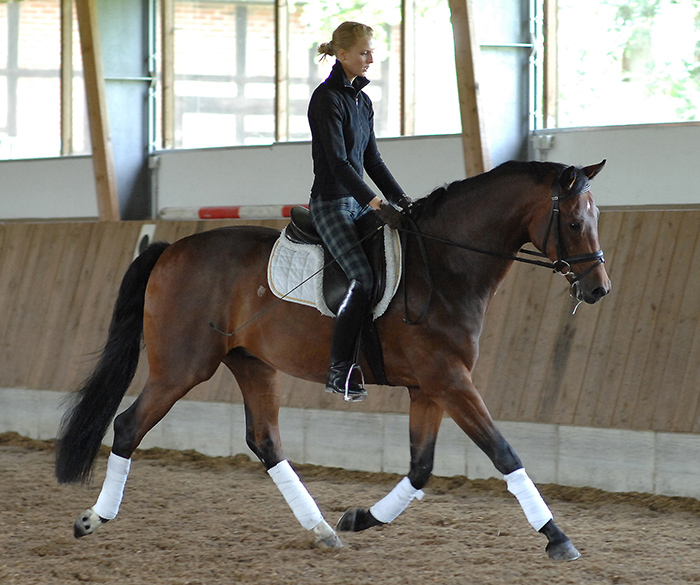
Obviously this phase calls for a sympathetic, very elastic rider who is able to sit independently from the hand and apply very soft aids.
After the first phase of walking the trotting begins, again with very light contact to the horse’s mouth. It is vital for the rider to find the most suitable basic pace for every horse. It is the tempo where the horse is balanced and trots forward and willingly without haste or stopping. Both rushing and laziness are indicators for the still missing looseness. Looseness, balance and in the end contact can be improved by frequent transitions, especially between trot and canter. Riding of slight changes in tempo can help as well as changing the rein often.
During the first month, ride on straight lines and big turns, on the rail, in large circles and with increasing balance, in serpentines of different forms. This improves the horse’s skills and helps to begin with bending of the ribcage. The young remount should be ridden predominantly in rising trot, because sitting trot begun too early and exercised for too long will make most horses stiffen their back. There is nothing wrong with short periods of sitting trot if the horse swings the back well. In canter the forward or even jumping seat also encourages a swinging back.
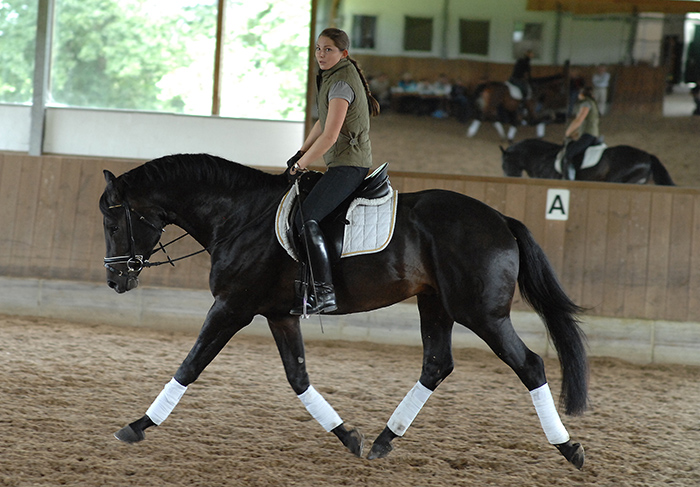
With growing confidence, meaning after several months, first exercises to move away from the leg can be started to familiarize the horse with the forward/sideways aids. First only at walk and later with more confidence in trot as well. Then half halts, with more control over the neck may begin, at trot-walk transitions, trot-canter transitions and with lengthening of the strides in trot and canter. It is important not to make the horse too short in the neck. It is vital to stay alert to the fact that the rider drives the horse from behind, towards the bit – not the other way around!
Done?
Finish of stage One
During every training session the willingness to stretch is tested by letting the horse take the rein from the rider’s hand, not only at the end but several times during the lesson. Let the horse take the rein all the way up to the buckle and you will receive important information about the value of your previous work.
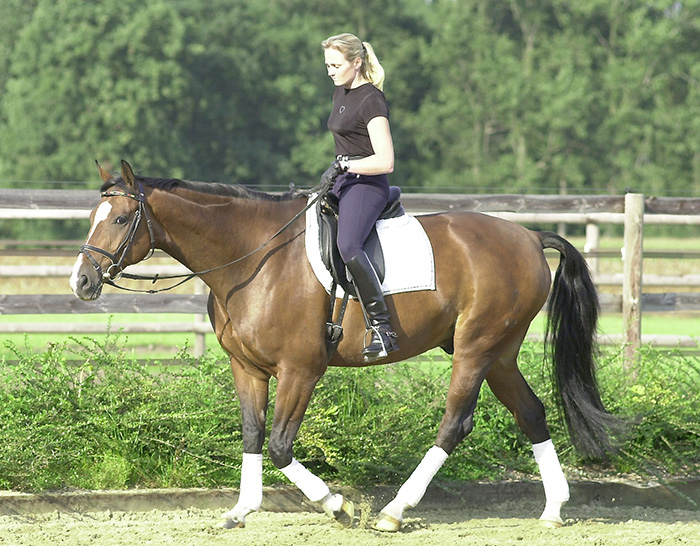
The first aim in basic training has been achieved if the horse knows and accepts driving aids, follows soft stopping aids and shows willingness to stretch at all times. That doesn’t sound like much … but it is a huge step in the right direction. A look back in history shows the aim for young remounts after six months: they should be able to canter, in a group of six – and on a loose rein!
Don’t forget variations
Even though the previous information applies mostly to basic training for dressage, training on the trail and over little jumps must not be forgotten. For the very talented (dressage) horses especially, their training can be extremely one sided and monotonous. With a little imagination variations can be included. Moving without a rider, free jumping, gymnastics over rails and little jumps have never harmed any horse and neither does trail riding or some hill work. Quite the contrary: it trains the horse’s body and mind, improves dexterity and suppleness and strongly influences the overall well being of the horse. A higher risk of injury is often touted as a reason to avoid all these variations but improving dexterity will serve to minimize the risk of injury. There is more than one reason for including as many variations as possible in the basic training of a young horse.
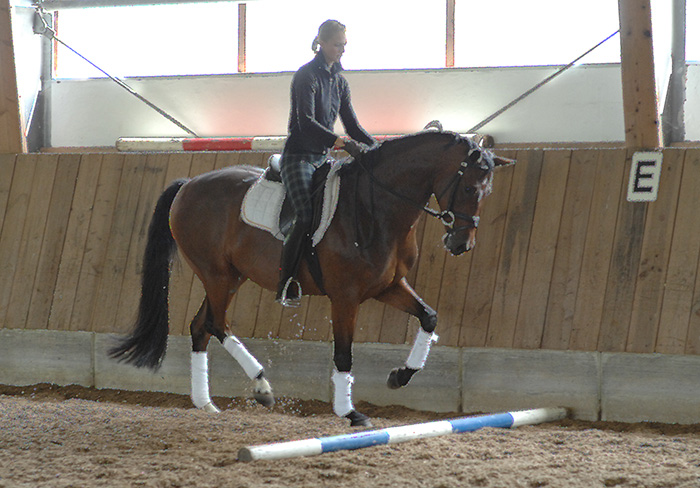
Are you on the right track?
‘Only if I know where I want to go, will I find my destination.’
This little bit of wisdom can be applied to basic training of a young horse. What is more, not only the big picture is important but many small steps have to be considered. Consider those and find out whether you are still on the right track.
Test yourself:
– The horse can be lunged without problems on both reins .
– It stands still when being girthed up and mounted, and having the girth tightened with the rider on.
– You can begin your working session walking on a long or even loose rein.
– While walking the horse shows the desired necking. (This necking is something Susanne considers very important. It is the gentle nodding of the horse’s head as it walks).
– The horse is steadily in front of your driving aids and trots off willingly after you take up the reins. Can you increase speed in trot and canter at any time?
– Can you trot steadily at an even basic pace, with the horse being loose and with a swinging back?
– Can you achieve an even contact with the horse’s mouth without having the horse too heavily on the bit or on the contrary being too light?
– Do you feel the horse evenly on both sides of the bit?
– Is the horse chewing contentedly on the bit?
– Can you start the horse dependably in canter on both leads? Does it remain at a steady pace?
– The horse stretches forward and downward when given the reins while maintaining an even pace?
– Can you make easy turns such as circles or large serpentines without your horse obviously losing balance?
– Does your horse follow calmly behind an older lead horse while on the trail?
– Do you notice slight changes in your horse? Can you notice more muscles in the upper neck and more solid back muscles?
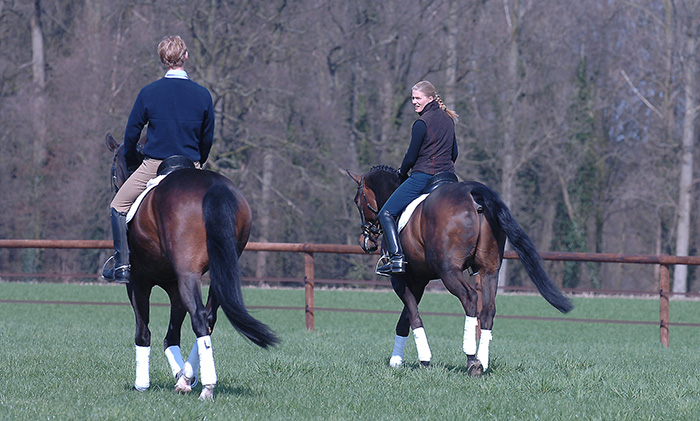
If you answered yes to most of the questions above you are on the right track. Under ideal circumstances this first stage should be achievable within four to six months. But don’t lose your patience if it takes you and your horse a little bit longer. It is a big mistake to make the second step before having satisfactorily completed the first!
This article first appeared in the February 2004 issue of THM.
Interested in breeding your own young horse? Go to www.ihb.com.au and choose a stallion – like Total Hope but check out the range, there’s all the best European bloodlines…
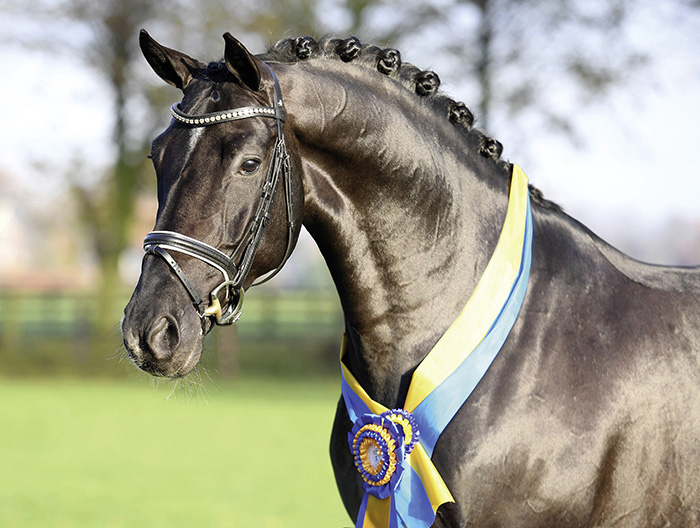


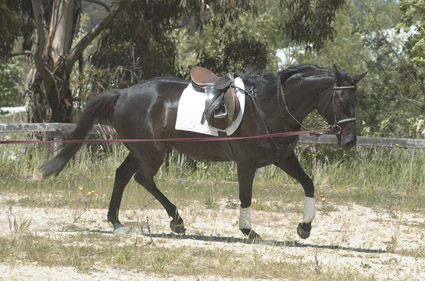
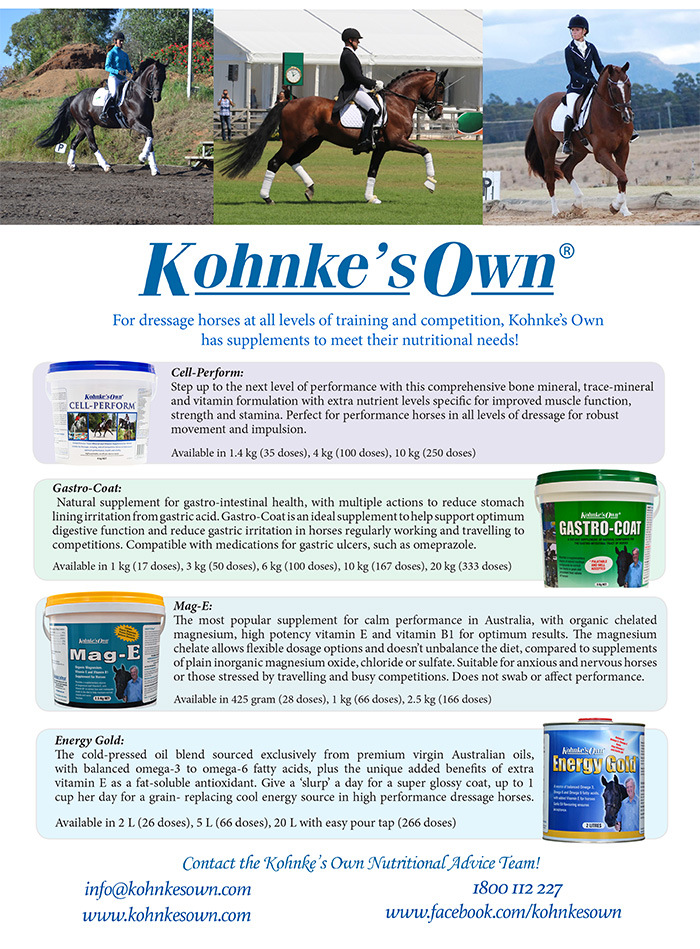

I BREED AND RAISE HANNOVERIAN WELL-BREED MOSTLY MARES AND A FEW STALLIONS SO I AM LOOKING FOR A COMPETENT, PROFESSIONAL, EXPERIENCED RIDER TO BACK YOUNG HORSES AND HELP MOVE THEM FORWARD WITH A SOLID PROGRAM TOWARDS DRESSAGE. RESIDENCE AVAILABLE. THANK YOU
973 222 3622